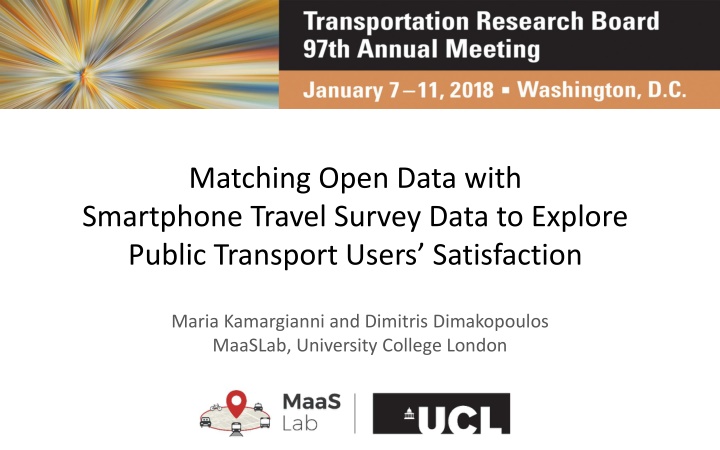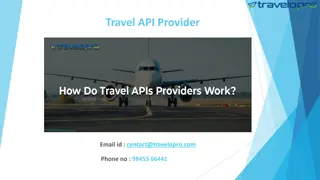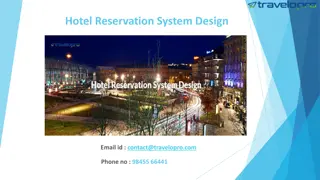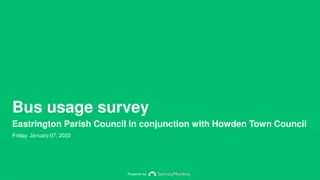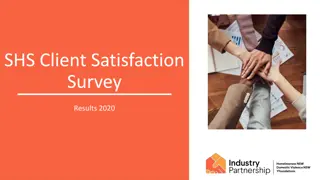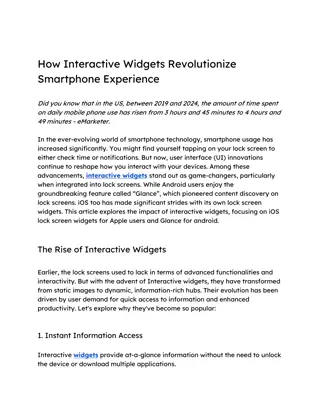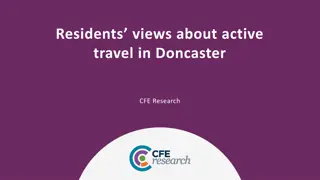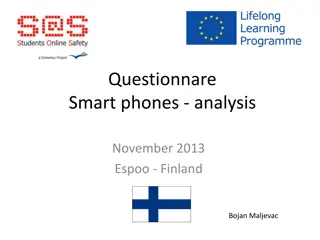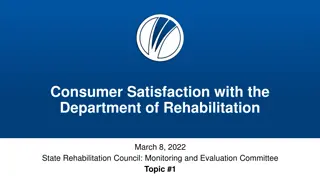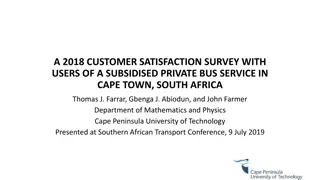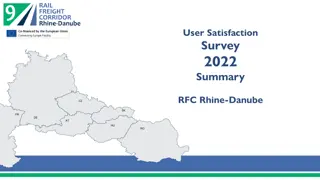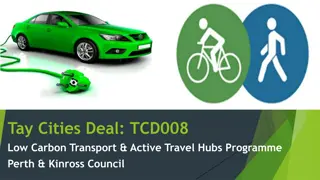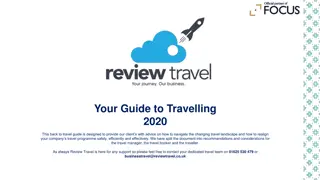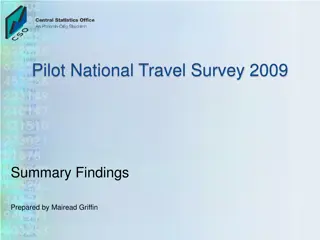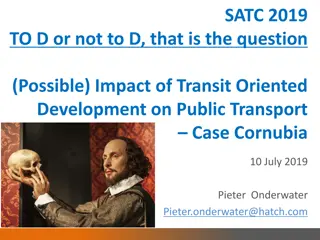Matching Open Data with Smartphone Travel Survey Data for Public Transport Users Satisfaction
Explore the satisfaction of public transport users by matching open data with smartphone travel survey data. The study aims to quantify the impact of longitudinal and open data on customers' satisfaction with rail-based public transport modes. This innovative research investigates various trip purposes and activities while traveling to derive better information affecting satisfaction levels. The methodology involves creating accounts, tracking activities with a designated app, and analyzing mobility records to generate hypothetical mobility packages.
Download Presentation

Please find below an Image/Link to download the presentation.
The content on the website is provided AS IS for your information and personal use only. It may not be sold, licensed, or shared on other websites without obtaining consent from the author.If you encounter any issues during the download, it is possible that the publisher has removed the file from their server.
You are allowed to download the files provided on this website for personal or commercial use, subject to the condition that they are used lawfully. All files are the property of their respective owners.
The content on the website is provided AS IS for your information and personal use only. It may not be sold, licensed, or shared on other websites without obtaining consent from the author.
E N D
Presentation Transcript
Matching Open Data with Smartphone Travel Survey Data to Explore Public Transport Users Satisfaction Maria Kamargianni and Dimitris Dimakopoulos MaaSLab, University College London
2 of 14 TRB 2018, Washington DC. Background Public transport authorities have done considerable efforts to evaluate the quality of their services and identify their customers needs in an effort to acquire new ones and retain the existing. With the increase of on-demand and ridehailing services, which seem to compete with public transport modes, the customer retention may be as equal important to the attraction of new ones (Rayle et al., 2016). => Customer satisfaction surveys are increasingly applied by public transport authorities, as a way to identify the expectations of both existing and potential customers.
3 of 14 TRB 2018, Washington DC. Objectives => Necessity to investigate public transport customers satisfaction using both perceived and objective data, => BUT also longitudinal data to derive more and better information about the factors affecting satisfaction. The aim of this study is twofold: 1. to describe the procedure of matching longitudinal smartphone based travel survey data with open operational data, and 2. to quantify the effect of both types of data on customers satisfaction with using rail-based public transport modes.
4 of 14 TRB 2018, Washington DC. Innovation To our best knowledge: there is no previous research that investigates customers satisfaction with public transport using both longitudinal and open performance data, while also compares the effect of activities while travelling on satisfaction. there is not any previous research that investigates the effect of different trip purposes (most of the available studies focus only on commute trips, while there are only few focusing on leisure trips).
5 of 14 TRB 2018, Washington DC. Survey design Step 1: create an account and answer to the pre-questionnaire Step 2: download the FMS app (Cottrill et al., 2013) and track their activities for 7 days. Respondents need to validate their travel and non-travel activities and answer some additional questions for each of their activities. Step 3: Exit section; respondents are shown with their Mobility Record. Based on their Mobility Record hypothetical monthly mobility packages are generated (Matyas and Kamargianni, 2017).
6 of 14 TRB 2018, Washington DC. Survey design Step 2: when the participants conduct a trip with a TfL rail-based mode (tube, overground, TfL rail, DLR and tram) they got the following questions: i. How many people travelled with you? (options: 0 to 5+), ii. How did you pay for this trip? (options: Oyster card-Pay as you go, Contactless, Smartphone pay, Travel pass, Other), iii. Which line did you travel with? (options: the 15 rail-based lines, other), iv. Were you doing any of the following on your journey? (options: Using mobile, Working, Listening to music, Watching movies, Playing games on mobile device, Reading adverts/posters, Daydreaming, Nothing, choose more than one), and v. How happy were you by using this mode? (7-point Likert scale, with a frown and a smiling face on the extremes).
7 of 14 TRB 2018, Washington DC. Survey design Dynamic/real-time open data is linked to each recorded activity
8 of 14 TRB 2018, Washington DC. Open data TfL data concerning the status of each rail-based public transport mode line. Special? Service? Closed? Suspended? Part? Suspended? Bus? Service? ? Planned? Closure? Minor? Delays? ? TfL Unified API lets one retrieve the status of all different TfL modes at any given time through HTTP (HyperText Transfer Protocol) requests. The status of a TfL line describes how the service is running at a given moment including information about possible disruptions. By repeatedly making such requests in 10-minute intervals we collect the TfL status data into a MongoDB database. Part? Closure? Severe? Delays? Reduced? Service? Exit? Only? Good? Service? Part? Closed? Diverted? Not? Running? Issues? Reported? No? Step? Free? Access? No? Issues? Change? of? frequency? Service? Closed?
9 of 14 TRB 2018, Washington DC. Data handling Matching open and travel survey data using machine learning algorithm (nearest neighbours) Google Maps API Retrieve Missing Values FMS dataset TfL data Temporal matching | TfL line | ... | status | timestamp | |user_id|...| TfL line | stop timestamp | Merged dataset | user_id | | happiness | TfL status | weather |
10 of 14 TRB 2018, Washington DC. Sample Data was collected between November 2016 and February 2017 (excluding the holidays). 157 individuals out of the 252 have used public transport modes. 1,323 stages by TfL rail-based modes. The minimum number of validated days is 1, the maximum is 9. The average number of stages per individual is 8.4.
11 of 14 TRB 2018, Washington DC. PT status, trip-stages & satisfaction
12 of 14 TRB 2018, Washington DC. Public transport satisfaction model specification Dependent variable: How happy were you by using this mode(for this specific stage)? => Ordered logit model Logit function: logit(gci)=log[gci/(1-gci)]=mc-bxi, with c=1,...,6 The probability of choosing response c on the Likert scale is given by: 1 1 P(c)= 1+e(mc-bxi)- 1+e(mc+1-bxi)
13 of 14 TRB 2018, Washington DC. Model estimation results (1/3) Linked? Open? Variables? ? PT? status:? Part? suspended? (1=yes,? 0=otherwise)? PT? status:? Part? closure? (1=yes,? 0=otherwise)? PT? status:? Severe? delays? (1=yes,? 0=otherwise)? PT? status:? Minor? delays? (1=yes,? 0=otherwise)? PT? status:? Good? service? (1=yes,? 0=otherwise;? PT? status:? limited? service? was? used? as? baseline)? ? Minor delays affect users satisfaction in a negative way, but this variable is not statistically significant. Part suspended , Part closure and Severe delays increase user s dissatisfaction. Severe delays is the most statistically significant variable indicating that users satisfaction strongly decreases when the services are running extremely late. Coef.? t-stat? -0.442? -0.138? -1.274? -0.216? 0.168? -4.56? -3.79? -7.92? -1.25? 3.25? 1?
14 of 14 TRB 2018, Washington DC. Model estimation results (2/3) Travel-related? Variables? (extracted? from? activity? diaries)? ? Travel? time? (in? vehicle? travel? time;? in? minutes)? Trip? started? in? peak? hour? (1=yes,? 0=otherwise)? Trip? ended? in? peak? hour? (1=yes,? 0=otherwise)? Accompanied? by? someone? else? (1=yes,? 0=otherwise)? Working? while? travelling? (1=yes,? 0=otherwise)? Listening? to? music? while? travelling? (1=yes,? 0=otherwise)? Watching? movies? while? travelling? (1=yes,? 0=otherwise)? Playing? games? while? travelling? (1=yes,? 0=otherwise)? Doing? nothing? while? travelling? (1=yes,? 0=otherwise)? Trip? purpose:? return? home? (1=yes,? 0=otherwise)? Trip? purpose:? work/? education? (1=yes,? 0=otherwise)? Trip? purpose:? work-related? (1=yes,? 0=otherwise)? Trip? purpose:? Personal? errands? /? Pick-up,? drop-off? (1=yes,? 0=otherwise)? Trip-stage? purpose:? Grocery? shopping? (1=yes,? 0=otherwise)? Trip-stage? purpose:? Sports/exercise? (1=yes,? 0=otherwise)? Trip-stage? purpose:? Entertainment? /? leisure? (1=yes,? 0=otherwise)? Trip-purpose? purpose:? Change? mode? (1=yes,? 0=otherwise)? ? Coef.? -0.004? 0.679? 0.251? 0.556? 0.26? 1.134? 0.291? 0.505? -0.260? -0.206? -0.309? 0.367? -1.07? T-stat.? -2.961? 1.967? 0.560? 2.30? 1.986? 2.764? 2.845? 3.366? -2.066? -1.722? -1.996? 2.004? -3.053? 0.179? 0.294? 0.426? 0.634? 1.306? 1.527? 2.168? 1.845? 1?
15 of 14 TRB 2018, Washington DC. Model estimation results (3/3) 1? ? Socio-economic? variables? ? Gender? (0=male,? 1=female)? Age:? 18? to? 30? years? old? (1=yes,? 0=otherwise)? Age:? 31? to? 45? years? old? (1=yes,? 0=otherwise)? Age:? 45? to? 60? years? old? (1=yes,? 0=otherwise;? baseline? is? the? >? 60? years? old)? Income? (continuous? in? )? Income? not? stated? (1=yes,? 0=otherwise)? PT? pass? holders? (1=yes,? 0=otherwise)? Having? a? disability? (1=yes,? 0=otherwise)? ? (parameter? accounting? for? correlation? accross? the? trips? of? the? same? individual)? Nagelkerke? pseudo? ? Observations? Coef.? 1.66? 0.17? 0.91? -0.76? -0.004? -0.78? 0.679? -1.887? 0.662? T-stat? 1.262? 6.636? 5.674? -3.457? -2.892? -1.969? 0.917? -3.096? 1.275? 0.589? 1,323? Gender does not play any significant role on satisfaction. Younger passengers, 18-30 and 31-45 age groups, seem to be more satisfied. As household income increases, the satisfaction with public transport usage decreases.
16 of 14 TRB 2018, Washington DC. Conclusions (1/2) Customer satisfaction is associated with the open PT status data. Activities while travelling and trip purpose affect customers satisfactions. These results provide insights for offering products that can advance customers experience in the MaaS and automated vehicles era that lies ahead: Listening to music, playing games and watching movies while travelling positively affects customers satisfactions. These are services that in the future could be included in MaaS subscription packages. These findings support the hypotheses that travel time could have a positive utility as it can be used productively for other purposes, such as working.
17 of 14 TRB 2018, Washington DC. Conclusions (2/2) Customer satisfaction varies from trip-stage to trip-stage as each trip-stage has each one conditions and characteristics. When satisfaction is aggregated into overall satisfaction with a specific transport mode, significant information is missed hindering transportation planning.
18 of 14 TRB 2018, Washington DC. Thank you! Maria Kamargianni m.kamargianni@ucl.ac.uk www.maaslab.org
